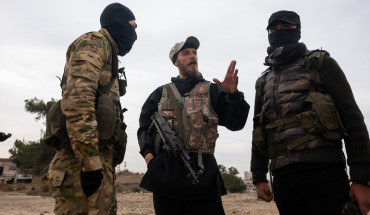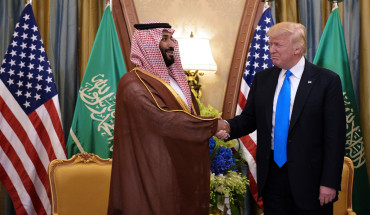When the Islamic State of Iraq and Syria (ISIS) overran Mosul last June, Grand Ayatollah Ali al-Sistani, the preeminent Shi‘i cleric in Iraq, called for voluntary jihad. The outlook for the central government was bleak. Reports from the battlefronts, as well as threatening statements by ISIS leaders, suggested that the capital Baghdad could also fall to ISIS. The group repeatedly massacred its captives and systematically destroyed important religious and cultural sites. Sistani’s June 13th fatwa served as a basis for the creation of an officially sanctioned paramilitary movement, al-Hashd al-Sha‘bi (Popular Mobilization), to provide support for the Iraqi Armed Forces in their quest to regain lost territory. The ad hoc character of the movement was later addressed with the appointment of a special commission to manage its affairs. Thus, according to the official narrative, the development of al-Hashd al-Sha‘bi was a reasoned reaction to a national emergency. An objective assessment of these paramilitary groups, however, reveals that their actions are pushing Iraq toward dissolution.
Al-Hashd al-Sha‘bi does not consist of new formations organized by the government in response to a national calamity, but rather marks official recognition of—and provision of material support to—existing militias. Many of these groups are well organized, and all are sectarian in their discourse and actions. While preserving their own leadership, command, and control structures, Hashd militias are supposed to coordinate with the regular armed forces. Yet the government’s endorsement has emboldened them to behave as sovereign forces, a condition that may prove difficult to reverse. Hashd militias seem more a response in kind to the adamantly sectarian ISIS than an attempt to counter its divisive agenda with one conducive to national unity—a fact underlined by reports of gruesome acts of vengeance by Hashd militias in areas recaptured from ISIS; the alleged killing of more than 70 civilians in Diyala in late January, which prompted an official investigation, is cited by critics as part of a pattern, not an anomaly. Corrective measures entertained by the Iraqi government, such as the parallel creation of National Guard units from Sunni tribes hostile to ISIS, are presented as practical steps, informed by the reality of a fragmented Iraq, to restore Baghdad’s authority.
Officially sanctioned paramilitary groups, however, amount to the central government’s surrender of its monopoly on the use of force. Their presence jeopardizes efforts to reassert a unified national authority and places Iraq on one of two negative trajectories: dissolution or effective power-sharing between the government and the militias along the lines secured by Hezbollah in Lebanon.
Tehran may be deliberately seeking the implementation of the Hezbollah model for the Shi‘i Iraqi militias—and could dispatch both Iranian Revolutionary Guard units and Lebanese Hezbollah operatives to support al-Hashd al-Sha‘bi. In Lebanon, the Hezbollah model is based on the illusion that domination by force will impose a lasting order, even while Hezbollah bears primary responsibility for the attrition of Lebanon’s institutional foundations, the sectarian polarization of Lebanese society, and the increased involvement of this small nation in regional conflicts. The temptation to follow the Hezbollah model in Iraq is compounded by two major negative factors—the decay of the Iraqi national narrative and the damage to the image of Sistani as a unifying national figure, as he is now tainted by a decision viewed by many as sectarian. These factors may thus contribute to the feared national degeneration.
After the founding of Iraq in 1920, the underlying currents of ethnic and religious factionalism were contained and attenuated through the emergence of a compelling Iraqi identity and culture energized through the rediscovery and appropriation of Iraq’s rich civilizational heritage. Reductionist nationalism, autocracy, the fallout from the Islamic Revolution in Iran, and the eight-year Iran-Iraq War subjected this common national identity to considerable strain. Further pressure was caused by the descent of Iraq into abject dictatorship, as well as by the international sanctions that depleted the already-battered Iraqi middle class. It was, however, the representation of Iraq as an amalgam of sub-national components—suggested by the opposition in exile and adopted by the occupation authorities after the fall of the regime in 2003—that sent Iraq spiraling into a self-reinforcing factional reality. An enlightened leadership would have been able to intercept and correct the negative trends, but the new Iraq was not so fortunate. Through commission and omission, in an apparent pursuit of the restoration of an autocratic order, former Prime Minister Nuri al-Maliki confirmed and exacerbated the Sunni-Shi‘i communitarian divide—enabling the flourishing of Shi‘i militias while resisting any meaningful accommodation of Sunni political demands.
In the absence of credible political efforts to transcend factionalism, the Sistani was repeatedly called on to champion national unity. While expecting Iraq to be Shi‘i dominated on account of demographics, Sistani favored stability, elections, and inclusiveness as the means to secure the new polity. A conservative, politically quietist cleric, Sistani openly dissents from the concept of wilayat al-faqih, “the rule of the Islamic jurist,” which places the clerical institution at the helm of decision making in Iran. However, events and the dysfunctional political order in Iraq have forced him to assume the role of national overseer—arbitrating disputes, validating national decisions, and restraining the excesses of Shi‘i militias and politicians. His June 13th fatwa, viewed as a factional call, constitutes a departure from his role as a unifying figure. Iraq, with Sistani’s image thus diminished, may be subject to more volatility. Paradoxically, however, Sistani’s retreat may also provide a new opportunity for a national leadership to emerge.
Combating ISIS is a mission that Iraq is undertaking on behalf of the world community. Baghdad is thus in a position to request and leverage meaningful international support. The global anti-ISIS effort cannot succeed if Iraq succumbs to sectarian factionalism. Containing and ultimately reversing the negative effects of the Hashd militias, avoiding further fragmentation by discarding the factional National Guards, and avoiding the replication of the Hezbollah model may thus be prerequisites for securing a victory against ISIS. Confronting these challenges now, even with the help of global and regional stakeholders, will not be easy. Dealing with them later, however, would likely prove even more difficult.
The Middle East Institute (MEI) is an independent, non-partisan, non-for-profit, educational organization. It does not engage in advocacy and its scholars’ opinions are their own. MEI welcomes financial donations, but retains sole editorial control over its work and its publications reflect only the authors’ views. For a listing of MEI donors, please click here.













